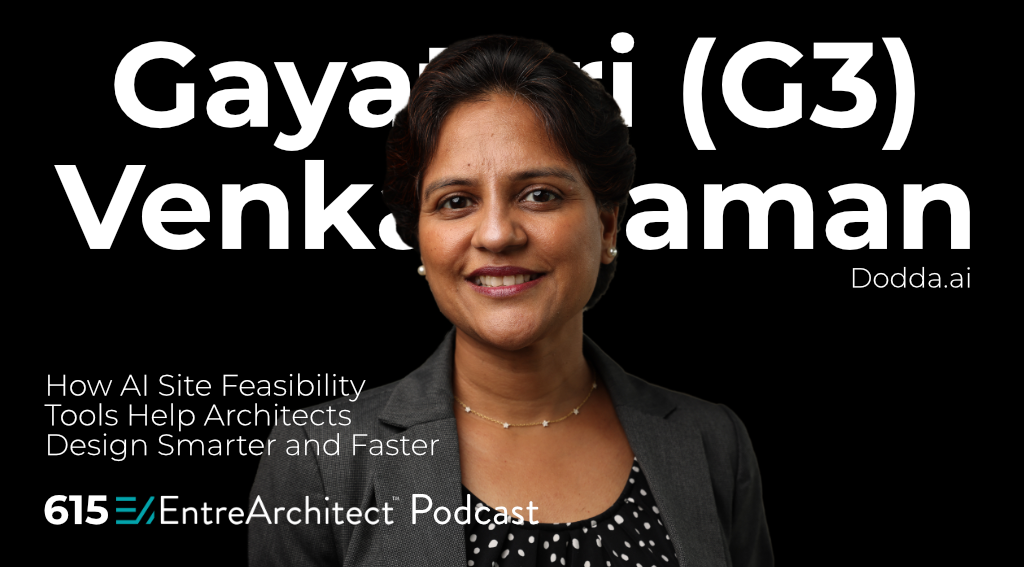
Every architect knows the frustration of starting a project with incomplete information. Before we can put pencil to paper, we spend hours digging for zoning codes, building restrictions, utility data, and environmental concerns, scattered across dozens of websites, agencies, and offices. What should be an exciting, creative process often feels slow, fragmented, and outdated.
On a recent episode of the EntreArchitect Podcast, I spoke with Gayathri Venkataraman—also known as G3—founder and CEO of Dodda.ai, a startup focused on solving these exact challenges. After more than 20 years of leadership at Microsoft and DocuSign, Gayathri turned her attention to the built environment, where she’s now working to apply artificial intelligence to help architects and developers assess site feasibility more efficiently and accurately.
This conversation was about more than just one company. It was about how we, as architects, can embrace emerging technology to solve real problems—and finally move past the tedious early-stage tasks that keep us from doing our best work.
The Real Problem with Early Site Analysis
For most of us, the process of determining what we can build on a piece of land hasn’t changed much in decades. We gather data from zoning departments, planning offices, GIS portals, and utility providers—often by phone calls, PDF downloads, and tedious manual searches. It’s slow, inefficient, and inconsistent.
This early-stage research is critical to project success, but it’s also where we lose the most time and energy. By the time we have a clear picture of what’s possible, we’re often burned out from the process of just getting there.
Technology has transformed other parts of our workflow—from design visualization to construction management—but site feasibility remains stubbornly manual.
How AI Can Help
AI alone doesn’t solve the problem. But when paired with the right data and a clear purpose, it can help architects access the information we need faster and more accurately.
Gayathri described how tools like Dodda.ai are pulling together zoning regulations, code requirements, environmental data, and utility information from trusted sources—consolidating what normally takes days of research into minutes. These platforms aren’t making the decisions for us, but they’re removing the friction of finding the facts we need to make smart ones.
Instead of scouring the web, we can start with a single address or parcel number and quickly understand the site’s opportunities and constraints. The result? We spend less time digging for data and more time designing buildings that work.
Accuracy Matters More Than Speed
One of the key lessons from our conversation is that speed means nothing without accuracy. As architects, we’re responsible for ensuring that every design decision complies with the local codes and zoning laws. If we base our work on incorrect information, we risk costly redesigns—or worse.
Gayathri emphasized that responsible AI development means sourcing data from verified, authoritative databases—not scraping unverified information from across the internet. And when an answer isn’t clear, a responsible tool says so, rather than providing an inaccurate guess.
That kind of transparency is essential. As architects, we must still verify the information we receive and make sure our designs comply with the latest codes and requirements.
The Opportunity to Do the Work That Matters Most
Let’s be honest: none of us became architects because we love zoning analysis. We became architects to create places for people—to design spaces that inspire, protect, and serve.
When we spend our days buried in research, we lose sight of the work that drew us to this profession in the first place. But if we can offload the tedious data gathering to reliable tools, we free ourselves to focus on the work we love.
That’s the real promise of AI-powered site feasibility. Not to replace our role as architects, but to clear the path for our creativity.
A Fragmented Industry Ready for Change
Site feasibility isn’t the only part of our workflow that’s fragmented. Across the construction industry, we use dozens of disconnected tools—for design, permitting, estimating, and project management. Rarely do these tools talk to each other. The result is duplicated work, lost information, and missed opportunities for better collaboration.
Gayathri and I talked about how the construction industry is full of smart, talented people solving individual problems, but rarely connecting them. The true opportunity lies in building tools that integrate our workflows—linking feasibility, permitting, design, and construction into a seamless process.
That level of integration is still on the horizon. But conversations like this one show that it’s possible—and that there are leaders in technology, like Gayathri, who are listening to architects and building the tools we really need.
What Should Architects Do Next?
You don’t need to be an AI expert to benefit from these tools. But you do need to start experimenting.
Pick one aspect of your workflow—whether it’s zoning research, code analysis, or permitting—and try out a tool that helps you work smarter. Don’t just take the results at face value. Ask tough questions about where the data comes from, how it’s validated, and what happens when the tool doesn’t know the answer.
Be curious. Stay skeptical. But don’t sit still.
Small firm architects are perfectly positioned to adopt new tools quickly. We’re nimble. We don’t need board meetings and committees to change the way we work. We can start testing today and adapt tomorrow.
The Future is Faster and Smarter
The early site feasibility process doesn’t have to be the frustrating slog it’s always been. With better tools and smarter workflows, we can spend less time on the paperwork and more time on the design work that truly matters.
The future of architecture isn’t about handing over our work to machines. It’s about partnering with technology to do our work better. And that future is already within reach.
If you want to hear more about how AI is reshaping the way we assess site feasibility—and learn how one tech leader made the leap from big tech to the built environment—listen to my full conversation with Gayathri Venkataraman on the EntreArchitect Podcast at https://entrearchitect.com/615.
And if you’ve experimented with AI tools in your own practice, I’d love to hear about your experience. What worked? What didn’t? Let’s keep learning together.
We don’t have to wait for someone else to lead this change. We’re the architects of our future.

Leave a Reply